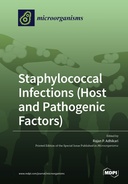Explore

Staphylococcal Infections (Host and Pathogenic Factors)
0 Ungluers have
Faved this Work
Login to Fave
Although 30% of the healthy human population is colonized with various Staphylococcus species, some staphylococcal strains, referred to as opportunistic pathogens, can cause minor to life-threatening diseases. The pathogenicity of these bacteria depends on their virulence factors and the robustness of the regulatory networks expressing these virulence factors. Virulence factors of pathogenic Staphylococcus spp. consist of numerous toxins, enterotoxins (some of which act as superantigens), enzymes, and proteins (cytoplasmic, extracellular, and surface) that are regulated by two-component (TC) and quorum-sensing (QS) regulatory networks. To enter this niche, some other Staphylococcus species, such as Staphylococcus simulans, produce a potent endopeptidase called lysostaphin, which can inhibit the growth of pathogenic S. aureus. Some other Staphylococcus species produce autolysins and cationic peptides to win the intra- and inter-species competition. The outcome of this microbial invasion depends not only on pathogenic factors but also on the host’s internal and external defense mechanisms, including a healthy skin microbiome. A healthy skin microbiome population can prevent colonization by other major pathogens. As normal host microflora, these commensals establish a complex relationship with the host as well as the surrounding microbial communities. This Special Issue of Microorganisms is focused on studies and recent advancements in our understanding of staphylococcal virulence mechanisms that enable Staphylococcus spp. either to successfully establish themselves as a colonizer or to overcome the host’s defense system to cause infection along with our effort to make an anti-staphylococcal vaccine.
This book is included in DOAB.
Why read this book? Have your say.
You must be logged in to comment.
Rights Information
Are you the author or publisher of this work? If so, you can claim it as yours by registering as an Unglue.it rights holder.Downloads
This work has been downloaded 105 times via unglue.it ebook links.
- 105 - pdf (CC BY) at Unglue.it.
Keywords
- adhesion inhibitor
- Animal Models
- arthroplasty surgery
- ATA
- aurintricarboxylic acid
- Biofilm
- Biology, Life Sciences
- Biomaterials
- CA-MRSA strain USA300
- carbon catabolite repression
- CC130
- CcpA
- chemokine
- Chronic wounds
- ClfA
- CM lipids
- Colonization
- community-associated MRSA (CA-MRSA)
- conjugated polysaccharide
- cytokine
- daptomycin resistance
- Dermatopathology
- dermonecrosis
- endotracheal tube
- food intoxication
- genome sequencing
- HL-60 cells
- host antibacterial response
- HPr
- human infection
- implantable devices
- Influenza Virus
- invasive disease
- JSNZ
- LPXTG
- mastitis
- Mathematics & science
- medical devices
- Metabolism
- methicillin resistance
- methicillin-resistant Staphylococcus aureus (MRSA)
- microbiota
- MntC
- molecular epidemiology
- mouse
- MRSA
- multidrug resistance
- mupirocin
- murine skin infection model
- n/a
- Neutrophil
- Nose
- nosocomial diseases
- Phase variation
- phylogenetic analyses
- Physiology
- PMNs
- pro-inflammatory response
- Protection
- Reference, information & interdisciplinary subjects
- Régulation
- Research & information: general
- resensitization
- rural Ghana
- SA4Ag vaccine
- sec variants
- Sepsis
- silver ion
- silver sulfadiazine
- small colony variants
- sortase A
- Staphylococcus aureus
- Staphylococcus epidermidis
- Staphylococcus lugdunensis
- super-infection
- superantigen
- surface proteins
- surgery-associated infection
- Titanium
- wound infections
Links
DOI: 10.3390/books978-3-0365-1417-8Editions

